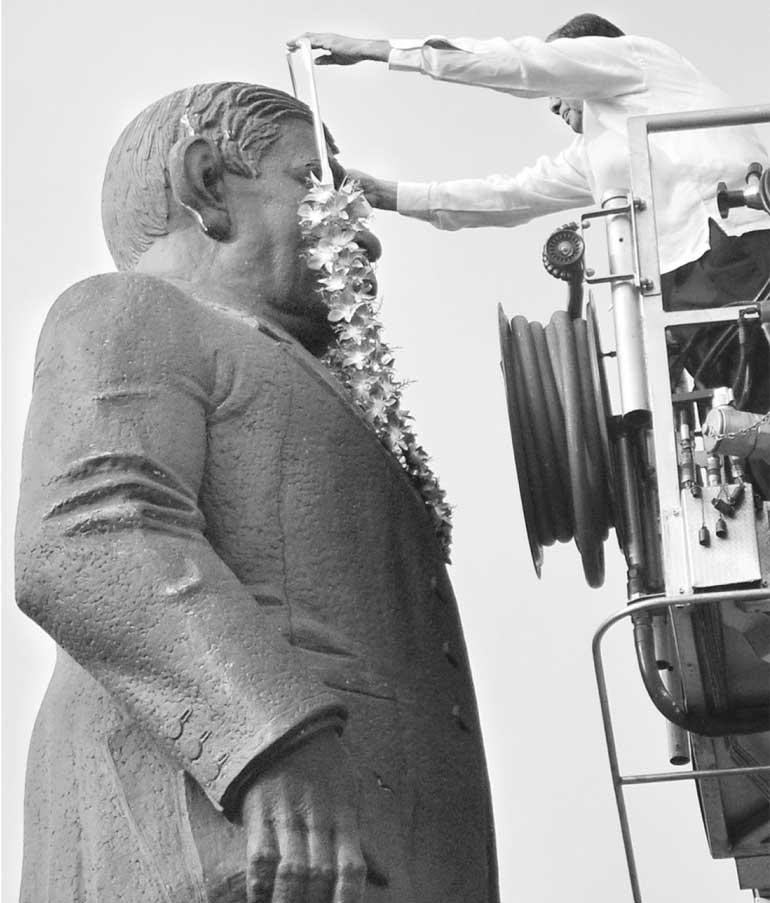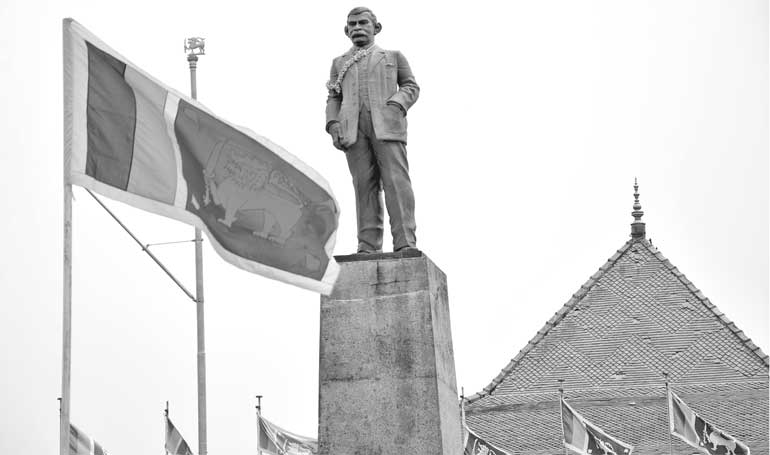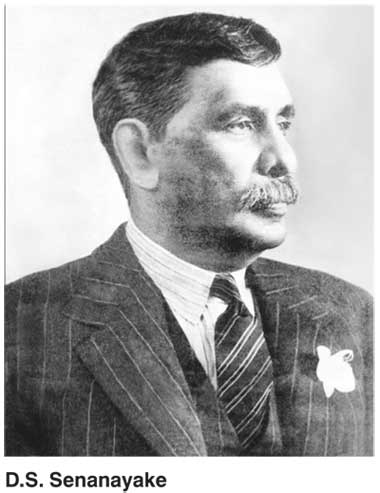Saturday Dec 13, 2025
Saturday Dec 13, 2025
Saturday, 6 February 2016 02:00 - - {{hitsCtrl.values.hits}}
By D.C. Ranatunga
Every year the ‘Father of the Nation’ is remembered on Independence Day. A dignitary garlands his statue at Independence Square and flowers are offered at the foot of the statue. The solemn remembrance was done last Thursday.
I decided to look up a few books in my library to pick up something different about Don Stephen Senanayake. I first turned the pages of ‘Among Those Present’ (1962) authored by one time doyen of journalism, D.B. Dhanapala.
“The remarkable thing about the first Prime Minister of Independent Ceylon was that there was nothing very remarkable about him he proved to be the most remarkable Ceylonese in modern times,” was the opening paragraph. “Don Stephen Senanayake who had been in politics for 30 years acted like a human juggernaut crushing all opposition under his overpowering personality.”
 CMC Mayor A.J.M. Muzammil paid homage to first Prime Minister of Sri Lanka D. S. Senanayake to mark Independence Day – Pic by Ishan Sanjeewa
CMC Mayor A.J.M. Muzammil paid homage to first Prime Minister of Sri Lanka D. S. Senanayake to mark Independence Day – Pic by Ishan Sanjeewa
“A burly, big made man with a hefty chunk for a chin, he looked the type that brooked no nonsense. But as his thick-set lips cracked open in a smile, there shorn forth vivid genuine geniality out of his rugged face. Generous, friendly and hospitable, around his rocky figure tempests lost their force,” he wrote.
‘DS’, as he was fondly referred to by many, entered politics just by chance, so to say. He was elected unopposed to the Legislative Council in 1922 as one of three Territorial Representatives for the Western Province. In 1931, he was again returned unopposed to the State Council from the Minuwangoda seat and was unanimously elected Minister of Agriculture and Lands, heading that Executive Committee. In 1942 he was elected Leader of the State Council replacing Sir D.B. Jayatilaka.
DS, the youngest of three sons of Don Spater Senanayake of Botale Walauwa, Mirigama, was “a good-for-nothing”, says Dhanapala. The eldest, Don Charles looked after the extensive business of exporting graphite (from the mines they owned) and copra (they had large acres of coconut) and the friends called him ‘Colombo John’. The second, Fredrick Richard had returned from London having been called to the Bar and was ‘London John’.
 The garlanded statue of D.S. Senanayake, the 'Father of the Nation,' at Independence Square – Pic by Upul Abayasekara
The garlanded statue of D.S. Senanayake, the 'Father of the Nation,' at Independence Square – Pic by Upul Abayasekara
At S. Thomas’ College, D S had preferred cricket to calculus; wrestling to writing; and riding fast horses in the open to reading slow Shakespeare in the class room. “Besides he was an engaging young ruffian who loved to roam the woods and pastures. The father promptly called him ‘Kelle (jungle) John,” says Dhanapala.
He also relates the story how when the father once asked the sons what their class test results were, the eldest said 20th, the next said 12th and the youngest said he was the fourth. The father was quite surprised. When the reports arrived by post it was realised that there were only four in the class! “In later years DS would relate how he would  manipulate to carry the Inspector’s bag from class-room to class-room on Inspection Day and manage to get a pass in his annual promotion test without being tested at the end of the day.”
manipulate to carry the Inspector’s bag from class-room to class-room on Inspection Day and manage to get a pass in his annual promotion test without being tested at the end of the day.”
Dhanapala mentions how once he got elected, DS made up for what he has lost at school by a painful process of wide reading and educating himself. How he performed is well-known.
Man of wisdom
My next search was ‘Three Prime Ministers of Ceylon – An Inside Story’ (1963) by J.L. Fernando, the veteran political commentator at Lake House newspapers during the D.R. Wijewardene era. From the time he was Minister of Agriculture in the State Council, to the week of his sudden death in March 1952, JLF had a confidential chat with DS every Wednesday morning at breakfast.
“Always there were string-hoppers on the breakfast table, the white variety for me and the brown variety for him to suit his ever-present diabetes. Always we served ourselves in total silence and then, just as he had brushed aside his moustache with his left hand and taken his huge mouthful with his right, he would say, ‘Well, what’s happening?’ From then onwards I would studiously draw out what was happening although it was he who had asked me the question,” JLF reminisces.
“One gathered a great deal of worldly wisdom listening to the ‘Old Man’ as he was popularly referred to. It was wisdom that could not be garnered from books,” he stresses.
DS was best known for his keen interest in reclaiming the jungles of the NCP, rebuilding the ancient tanks and turning the arid land into green paddy fields and orchards to increase the country’s paddy supply. JL writes the story DS had told him on how all that started.
“During the old Legislative Council days when Ceylon was still tied to the apron strings of imperial Great Britain, DSS was one of several members of the Council who rode in the first train running on the new railroad extension to the Eastern Province. On the way the official train had been halted near the fringe of the thick jungle at a place now known as Hatamune and the councillors and other officials had got off the train to loosen their limbs. Senanayake had left his colleagues and walked into the jungle searching for a secluded place to empty his bladder and then he had seen an expanse of gleaming water through the giant trees. Going towards the water he had come upon the remains of an ancient tank. It was there, pondering over the banks of a former Sinhalese king’s tank that inspiration came to Senanayake.”
In the years that followed he had realised his great ambition and the NCP – Minneriya, Kalawewa, Goiritale, Paraktrma Samudra schemes – was covered with green paddy fields, flowing water and colonists’ settlements.
JLF relates many stories of how DS discussed strategies with his inner Cabinet members Sir Oliver Goonetilleke and Sir John Kotelawela over lunch at the Prime Minister’s office in the Senate building. All the moves and counter moves were planned at those lunch discussions.
‘Charming friend’
To end these little known tales here is what Lord Soulbury says in an article he wrote on ‘DS Senanayake the man’: “I arrived in Ceylon as Governor-General on July 6th, 1949 and from that day onwards DS used to come to see me at Queen’s House about once a week – a very useful and helpful practice for both of us – a practice I am glad to say was continued by DS’s successors. I used to look forward with keen pleasure to my talks with him. He brought into my office the fresh air of the countryside, the breezy cheerfulness and good humour of a charming friend. He never seemed worried or depressed and I still seem to hear his hearty chuckle, and can recall his little mannerisms, such as the use of the word ‘absolutely’ whenever he wished to express agreement. But we did not always agree and yet looking backwards I think that when we differed he was much more often right than wrong.” (The Ceylon Historical Journal – DS Senanayake Memorial Number April 1956).